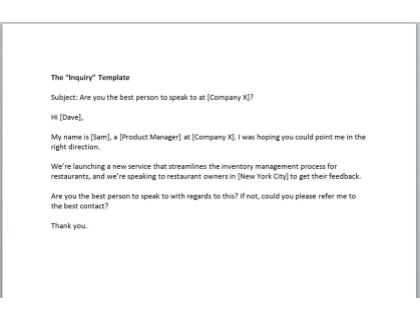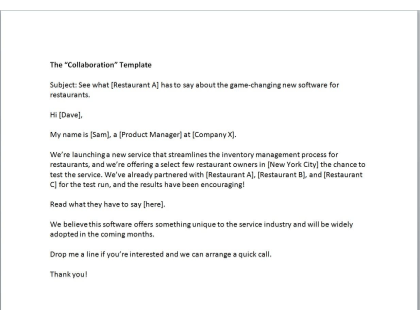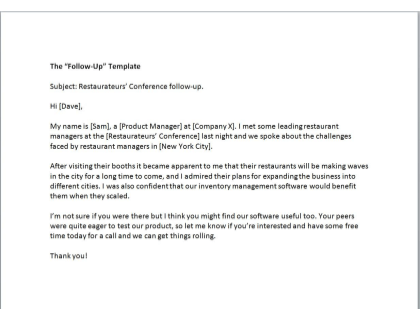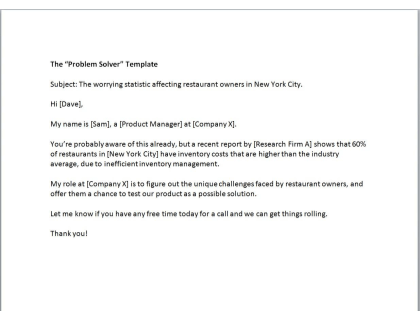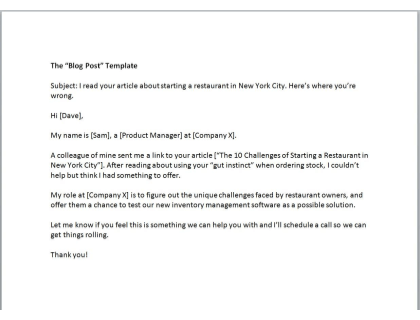Cold Email Templates
Get free cold email downloadable templates, as well as best practices for crafting persuasive cold emails that drive sales.
Updated on August 2nd, 2024
The SMB Guide is reader-supported. When you buy through links on our site, we may earn an affiliate commission. Learn more
Cold emails are sales pitches to clients with whom you have no previous relationship. The recipient of a cold email is a person or company that falls within your customer profile. The cold email seeks to initiate a relationship in the hopes of making a sale.
Research by Stastica and Forbes shows that email has been on an upward trajectory that will continue into 2022, and that millennials use email as their primary source of doing business, so there is great potential in email to generate sales.
It is tempting to have your sales team compile a database of email addresses for you to mass-email in the hopes that something will stick, but this strategy is unlikely to translate into anything meaningful. Persuasive cold emailing requires you to get creative, do some research, and think outside of the box. Successful cold emails treat each potential customer as an individual, and makes the email as personalized as possible.
Cold Email Best Practices:
Before you write your email, clarify the Call-to-Action you are making (what you want your recipient to do). This serves as your objective.
Personalize your email. Find out what work they're doing, and what problems they're experiencing. A personalized touch is more likely to catch the eye and not be ignored.
Check their LinkedIn and X profiles, as well as their blog posts, to see what they've been up to recently.
Be thoughtful. A considered, well-researched email will show them that you understand their business model, their unique challenges, and that you can offer them a solution.
Write as an employee of a company and not on behalf of a company. You want to form a personal connection. Introduce yourself, and briefly tell them what you do at your company.
Personalize your subject line. The subject line is the first impression of your email and can often be the difference between clicking and scrolling by. 35% of recipients open emails because of the subject line. Include the recipient's name in the subject line and try to grab their attention by personalizing it.
Open with your elevator pitch. This is a short, snappy paragraph summarizing what you are offering and how your proposed relationship will benefit them.
If relevant, namedrop some big clients you've helped. Citing previous successes adds credibility to your pitch.
Ensure that your Call-to-Action is simple and clear. Link out to any forms or pages from the email. See to it that your email only tries to achieve one thing.
5 Persuasive Cold Email Templates:
Type of Cold Email | Strategy |
|---|---|
Disguise your sale as an inquiry. | |
Offer them an opportunity at a useful collaboration. | |
Follow-up after an event. | |
Initiate a relationship by offering to solve a problem. | |
Pick a blog post of theirs that describes a problem they're having and suggest a way of solving it. |
The 'Inquiry' Template:
This approach presents itself as an inquiry. The sender briefly introduces himself and his company, without giving away too much about their business. He then asks the customer if they are the best person to speak to with regards to this issue. This method is successful because the customer is more likely to respond to you or redirect you to the proper person to speak to. Once they reply, they have initiated a relationship.
The 'Inquiry' Template
Check out our 'Inquiry' Cold Email Template in Microsoft Word format.
The 'Collaboration' Template:
This approach aims to make the customer feel like they're missing out on an opportunity that was seized by one of their competitors. If you have already conducted business with one or more of their rivals, simply email the customer telling them about your new service that has had favorable feedback from their competition. Name the businesses. If the customer feels like they might be falling behind by not trying out your service, they are likely to respond.
The 'Collaboration' Template
Check out our 'Collaboration' Cold Email Template in Microsoft Word format.
The 'Follow-Up' Template:
This cold email is sent to a customer the day following an industry event. Tell them that you attended the event and learned about the big players in their industry, and that they expressed an interest in your service. If they attended the event, the email would feel personal and genuine, and if they did not attend the event, or didn't know about it, they would recognize you as someone credible with an interest in the industry. This makes them more likely to respond.
The 'Follow-Up' Template
Check out our 'Follow-Up' Cold Email Template in Microsoft Word format.
The 'Problem Solver' Template:
Try starting the email by referencing a credible report that pertains to their industry, then talk about your service and how you've helped businesses like theirs. Essentially, you are bringing their attention to a problem they ought to be aware of and offering to help solve it by pitching your service. Remember to link out to the report for them to read themselves.
The 'Problem Solver' Template
Check out our 'Problem Solver' Cold Email Template in Microsoft Word format.
The 'Blog Post' Template:
Read a blog post on the customer's website that relates to a problem they're having (and a problem you can solve). Tell them you're aware of this particular issue, and offer to help them solve it. This approach is effective because it tells the customer that you took the time to get to know their brand and how their business works. The more detailed your appraisal of their business, the more likely you are to get a response.
The 'Blog Post' Template
Check out our 'Blog Post' Cold Email Template in Microsoft Word format.
Pros and Cons:
Pros
- A low-cost way of reaching new clients.
- Less intrusive than cold calling.
- Recipients can read at their own leisure, and don't feel hassled for a response.
- Gives you an opportunity to create a good first impression of your business.
- Cold emails can be forwarded to someone more suitable to respond.
Cons
- Successful cold emailing requires time and effort.
- Automated cold emails save time but are easier to dismiss as spam, or fall victim to spam filters.
- Recipients don't feel any pressure to respond.
- Requires good, persuasive copywriting skills.
- There is the potential to breach the CAN-SPAM Act regulations and incur heavy penalties.
FAQs:
How do you write a cold email?
Cookie-cutter approaches to cold emails do not work. Successful cold emails, those that generate a response, are so because they treat the potential customer as an individual with unique challenges to overcome. Some common best practices for cold emails include researching the client's business model, grabbing their attention from the subject line, and giving them a simple and clear call-to-action.
Is cold emailing illegal?
No. Cold emailing business prospects is a perfectly legal practice. However, the CAN-SPAM (Controlling the Assault of Non-Solicited Pornography And Marketing) Act regulates emailing in the U.S., and breaking a CAN-SPAM rule can cost you up to $40,000.00 in penalties. Abide by the following rules.
- Do not deceive your recipient with a subject line that is untrue, or unrelated to the email.
- Provide an opt-out option to never receive messages from you again.
- Always honor their opt-out request by removing them from your list.
- Never lie about who you are, where you're from, or who you work for.
What is cold email marketing?
Cold email marketing is the process of reaching out to potential customers with whom you share no prior relationship, via email, in attempt to sell them something. Cold emails seek to initiate a business relationship with an individual, rather than mass email potential clients.
Is email better than cold calling?
There are merits to both methods, but a successful sales strategy will combine both. Cold emails excel at being convenient. Customers don't have to sit through a disruptive phone call. They can read their emails at their own leisure. This pro is tempered, however, by the fact that nearly 60% of cold emails are ignored as they are considered spam. Cold calling, on the other hand, gives salesmen the opportunity to flex their persuasive skills, although email has replaced phone calls as the preferred business communication method, meaning fewer people are picking up the phone.
Can I cold email under GDPR?
Yes. General Data Protection Regulation is designed to ensure that user data is properly protected and processed, so as long as you comply with data protection standards, cold emailing is perfectly fine.
What is a good response rate for cold emails?
10% is considered a good response rate if you're an experienced email marketer and have put in the right amount of effort. 5-10% is also a decent score.
What is a good open rate for cold email?
A good open rate for cold emails ranges between 15% to 28% depending on your industry. Daily deals and e-coupon emails have a 15% open rate, while emails about hobbies have a 28% open rate.
How much does an email list cost?
An email list can cost between $200.00 and $400.00 CPM (cost per thousand impressions) for a consumer list, and $300.00 to $600.00 for a business list. A list like this will include 2,500 to 5,000 names and addresses.
How many words should a sales email be?
Cold emails should be succinct and to-the-point. As a general rule, cold emails should not exceed 200 words.

